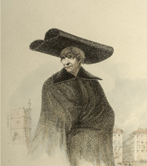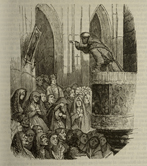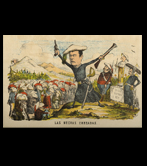The profound influence of the Church
The Church was very powerful in 19th century Gipuzkoa. The population was mainly rural, dispersed in caseríos, and the parish church was the main meeting place. It was there that people received information, whether the bishops’ pastorals or the latest decisions made by the local authority or the Diputación. Every Sunday, the pulpit became the main source of news. The word of the priest was beyond question, and the sermons, homilies, advice and orders he delivered were received as “the word of God”. Given that most official business was both in writing and in Spanish, by speaking in the only language that they understood, Euskera, the priest became an understandable and accessible authority.
One objective of the Basque Diputaciones in the middle of the century was the creation of a single bishopric for the three provinces. Until 1861, the Basque region came under four bishoprics: Calahorra, Pamplona, Santander and Baiona. The Álava Diputación had been petitioning for years for the establishment of a new bishopric in Vitoria as a means of reviving the local economy after the loss of trade caused by the transfer of the customs post to the coast. The bishops under whose jurisdiction they fell, however, were opposed, arguing that such a decision carried with it serious political risks. Justo Barbagero, the bishop of Calahorra, claimed: If the Basques have a bishop who speaks their language, a local authority and parish church that speaks their language, pastorals, sermons, books in their language, they will seize upon this, and push it to the limits of the three provinces, regaining lost ground and turning it into a national language.” And he concluded: “and if you add to this the growing fondness for their customs, traditions and fueros, which are informally authorized and sanctioned, it will contribute to the creation of a separate nationality within the Spain, and the basis for political separation for those who invoke the principle of nationality.” In spite of all the obstacles, the Basque Diputaciones achieved their objective in 1862.
The creation of the Basque diocese gave new impetus to clerical influence. The bishopric organized missions to various places to preach against sin and to spread its ideology. In its first decade it organized 32 missions, in which the missionaries, Jesuits and Franciscans heard Mass and confessions. In Mondragón, for example, in 1863 1,200 people took communion and in Zaldibia two years later, 2,500. The missionaries worked 12-hour days hearing confession. It might be assumed that so much effort would achieve results, and that the new diocese would succeed in spreading its message at what was a critical moment for the Church.
The 1868 revolution dealt a serious blow to the interests and moral authority of the Church. Freedom of worship, the exile of the Jesuits and civil marriage were seen as a direct attack on the Catholic religion. After the expulsion of Isabel II and the enthronement of Amadeo de Saboya the - the son of a king who stripped the Pope of his territories - the proclamation of the Republic caused a deep wound in an already offended Catholic Church.
In Gipuzkoa the Juntas Genrales de Hondarribia of 1869 led to a radical change in the relationship between the Diputación and the Church. The Carlist representatives left the Juntas when they approved, on the one hand, the parish reform that abolished tithes and, on the other, the decision to appoint priests to parishes in proportion to the number of inhabitants, effectively reducing their number. In Oiartzun, for example, their number fell from nine to six.
After similar measures had been adopted without the bishop’s agreement, the majority of the clergy backed the Carlists in the 1872 uprising. The priest Santa Cruz was a prime example of the Basque clergy’s participation in the Second Carlist War. In 1873 the Gipuzkoa partisans appalled both the Liberal government of the Carlist authorities in because of their fanatical, cruel and undisciplined attitude when it came to defending “the cause of God”.
When the Second Carlist War ended in 1876, during the Restoration of the monarchy the Catholic Church was able to maintain its influence over the people of Gipuzkoa, and the Basques in general, despite having lost some of its privileges, as can be seen in the rise of Fundamentalism, an ultra-Catholic schism within Traditionalism, and the religious tendencies of early nationalism.




